If you like big bundts, you’ll love this Orange Bundt Cake! This classic homemade bundt cake has a tender texture, a bright orange flavor, and is drenched in a tangy orange glaze.
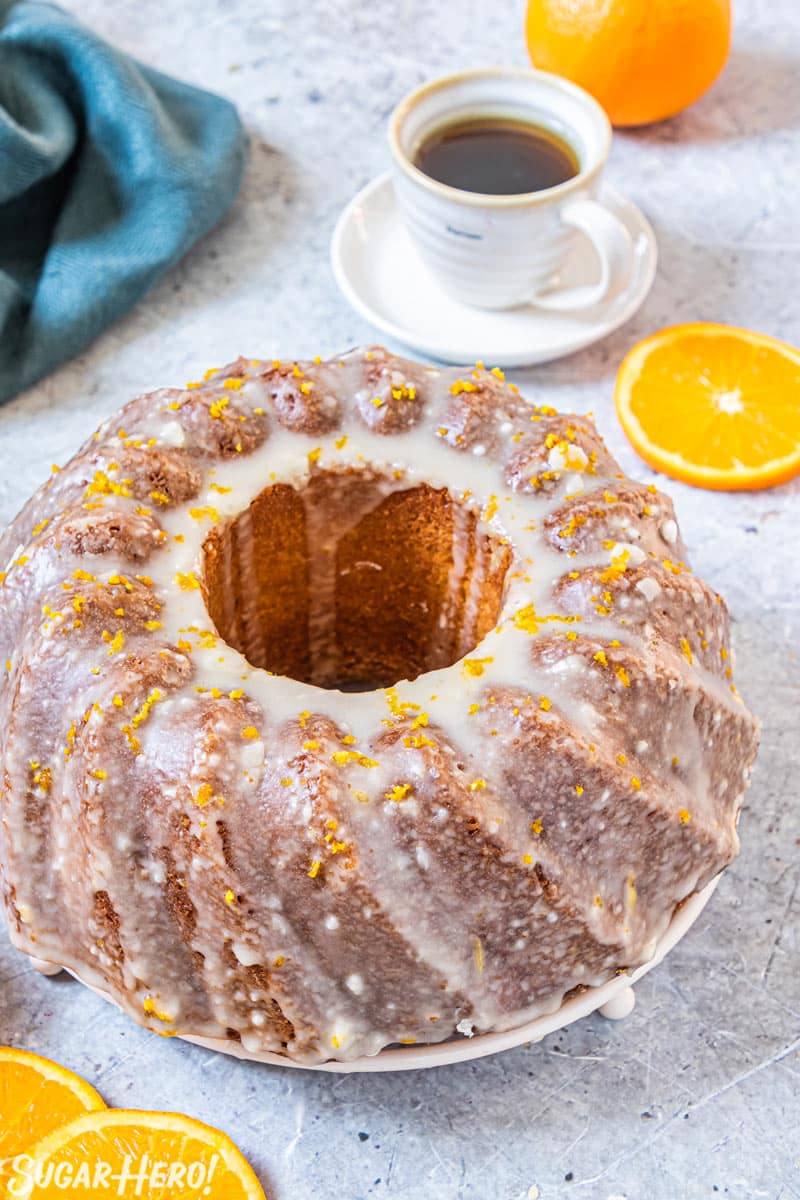
🍊 The Best Orange Cake with Orange Glaze
Today’s cake combines two of my favorite things: big, bold citrus flavor, and ultra-tender and moist cake. (Can I get an amen?!) Let’s take these one at a time:
Bright, zesty orange is one of my favorite flavors to add into cakes and baked goods. Oranges are the best because they’re available year-round, even mediocre oranges can yield delicious zest and juice, and orange pairs well with basically everything. Got chocolate? Make chocolate orange cake or orange brownies. More of a white chocolate person? Then make yourself some white chocolate-orange candy bars. Like to sip your orange desserts? This orange hot chocolate has your name on it! There’s really no wrong way to enjoy orange desserts, and I’ve made it my mission to try and cram it into as many recipes as possible.
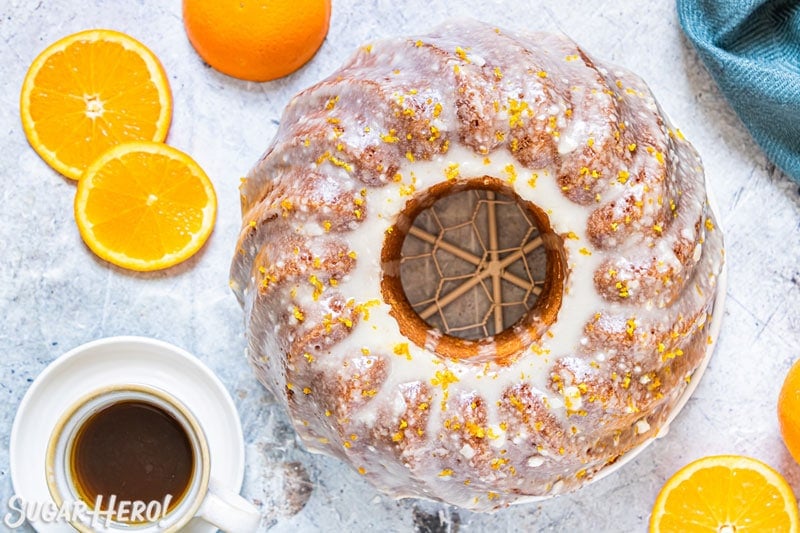
And why choose a bundt cake? A giant frosting-filled layer cake is fantastic, but sometimes nothing hits the spot like a classic bundt cake. The simple nature of a bundt cake really lets the citrus flavor shine. Buttery and moist, this cake is adorned with an easy orange glaze and isn’t too rich or sweet, so it’s perfect as an afternoon snack, tea-time treat, or after-dinner dessert. If you want to get more use out of your bundt pan, try our Cinnamon Swirl Pumpkin Pound Cake, Roasted Banana Bundt Cake, or reader favorite Strawberry Swirl Bundt Cake!
Table of Contents
🧾 What You’ll Need
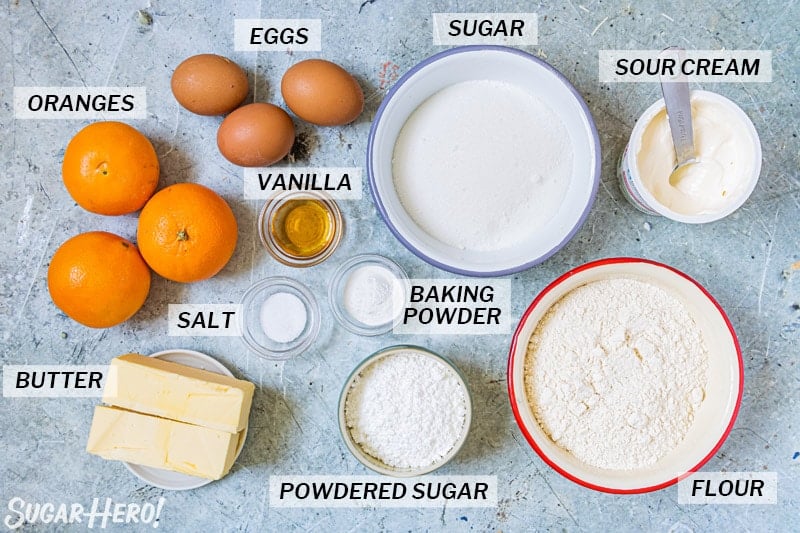
Ingredients
No surprises here–the ingredient list is full of pantry basics you probably already have. A few notes to keep in mind as you gather ingredients:
- Oranges: No shortcuts, please! You definitely want to use fresh oranges for this recipe, at least for the zest and preferably also for the juice. To select the best fruit, you’ll want to look for heavy oranges with a bright orange color and a slight give when you squeeze them. Since you’ll use these oranges for both juice and zest, pick up 3 large ones just to be safe.
- All-purpose flour: If you need to make this gluten-free, you could try the recipe with a gluten-free all-purpose flour.
- Unsalted butter: Butter in cake batters help to give the cake a moist, rich flavor. You can use salted if that’s what you have, and reduce the amount of added salt to taste.
- Sour cream: Sour cream has a lot of fat in it, which gives the cake extra moisture and richness when it’s done baking. No sour cream? Try substituting full-fat plain Greek yogurt instead.
- Sugar: We’re using two types of sugar in this recipe: granulated sugar (for the batter and soaking syrup), and powdered sugar, for the orange glaze that is drizzled on top.
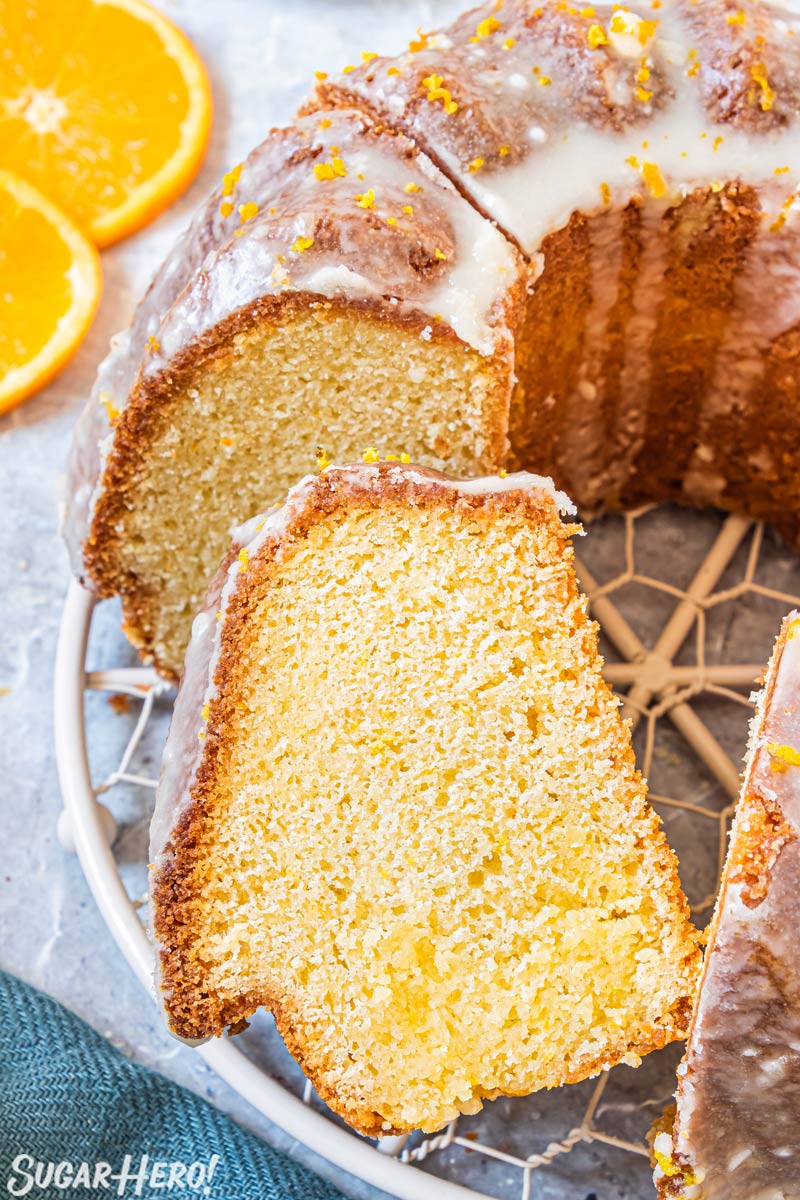
Equipment
Here’s what you’ll need to make this cake. You’ll find that a lot of these gadgets are handy for a lot of different projects around the kitchen too! (Links are affiliate links and I earn a small commission from qualifying purchases.)
- Bundt pan: OBVIOUSLY you’ll need a bundt pan to make a bundt cake! If you’re going to buy your first bundt pan, I highly recommend this Nordic Ware pan. It’s cast aluminum, meaning it’s solid and heavy duty, and it can handle volumes anywhere between 10-15 cups of batter. It’s super versatile and the perfect pan for a bundt newbie.
- Juicer: A countertop juicer is just the thing for getting the fresh orange juice you need. This one is very affordable and gets the job done!
- Microplane: In my opinion, a microplane is a kitchen must-have. It’s a very fine grater that makes zesting citrus very easy and fast. It’s also great for chocolate, whole spices, and parmesan cheese, so chances are you’ll find yourself reaching for this little tool all the time.
- Mixer: When it comes to stand mixers, KitchenAids are hard to beat. They last a long time and you can get all sorts of attachments to help make homemade pastas, grind your own meat, or spiralize your favorite veggies.
- Wire cooling rack: This wire rack is a lifesaver if you bake cookies, cakes, or other tasty treats. For bundts, it’s especially important to cool the cake in the pan for awhile before removing it and letting it cool on a wire rack.
📋 Instructions
Here’s a quick run down on how to make the Orange Bundt Cake, glaze, and syrup. For the complete recipe, check out the recipe card below!
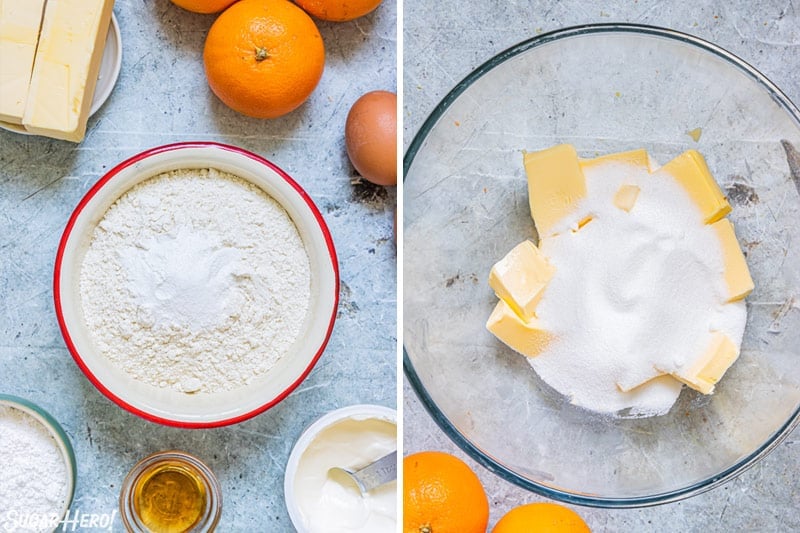
Making the Orange Cake Batter
- Start by preheating the oven to 350°F. Prep your bundt pan by brushing on a thick layer of homemade pan release, or spraying it with nonstick cooking spray. (If you do that, I strongly recommend using the “Baker’s” variety of nonstick spray with the added flour.)
- In a small bowl, whisk together the flour, baking powder, and salt and then set aside.
- Cream together the room temperature butter and sugar until light and fluffy, about 2-3 minutes.
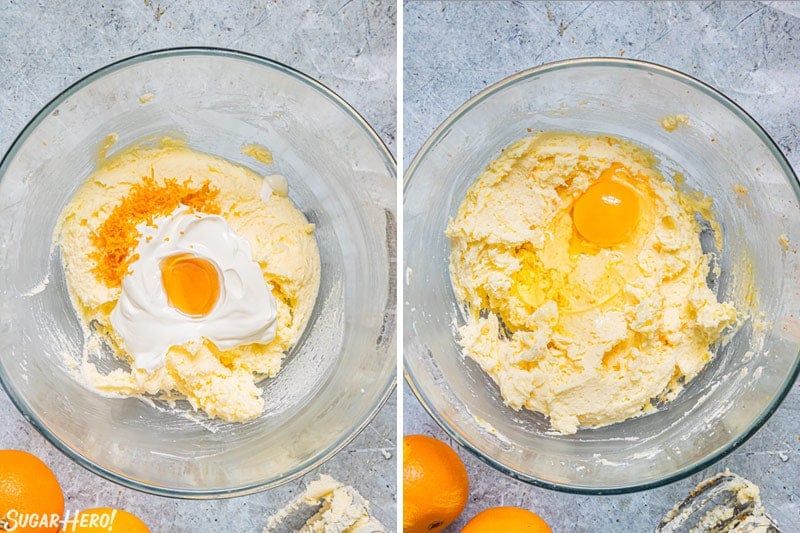
- Once the butter and sugar are fluffy, beat in the orange zest, sour cream, and vanilla.
- With the mixer on low speed, add the eggs, one at a time, and beat just until combined. Do not over mix! At this point, the batter might look curdled or broken but don’t worry! It will come together when you add the flour mixture into the mixer.
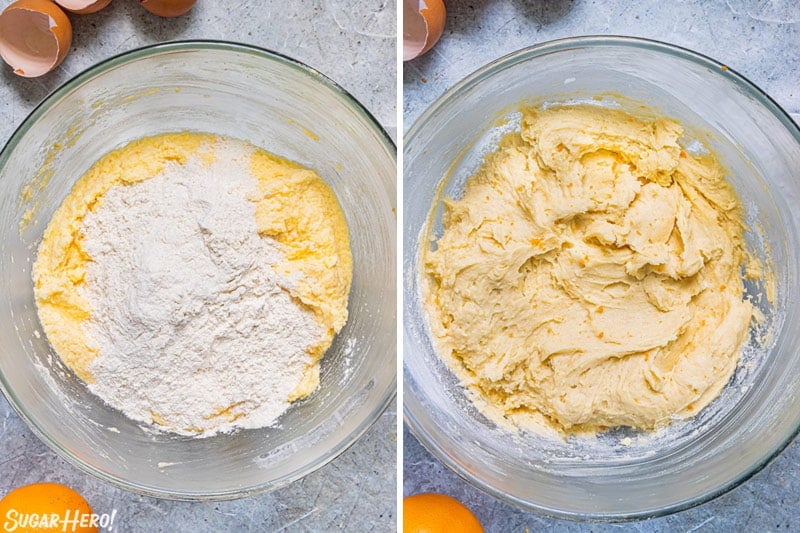
- Use a spatula to gently fold in the flour mixture until just combined. Avoid over-mixing, since this will make your cake tough.
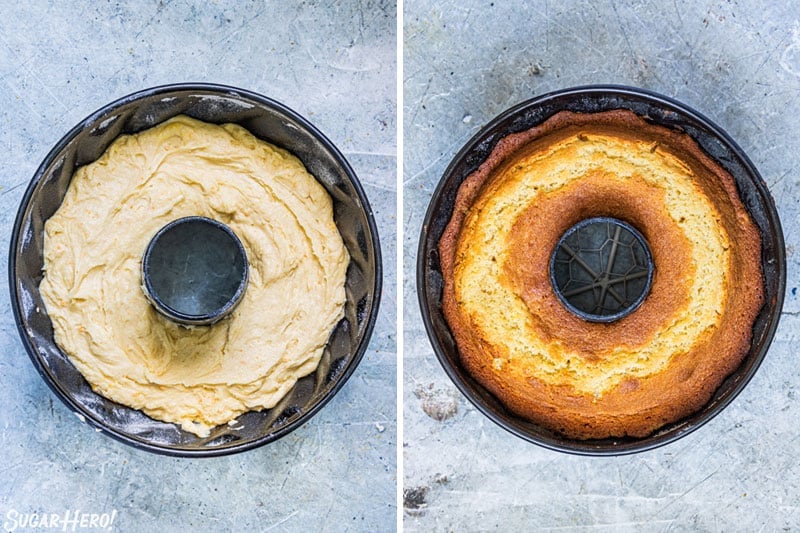
- Transfer the batter to the prepared bundt pan. When it is all in the pan, tap it gently a couple of times on the kitchen counter to level it.
- Bake the cake in the pre-heated oven for 50 to 60 minutes, or until a wooden skewer inserted into the center of the cake comes out with just a few moist crumbs attached.
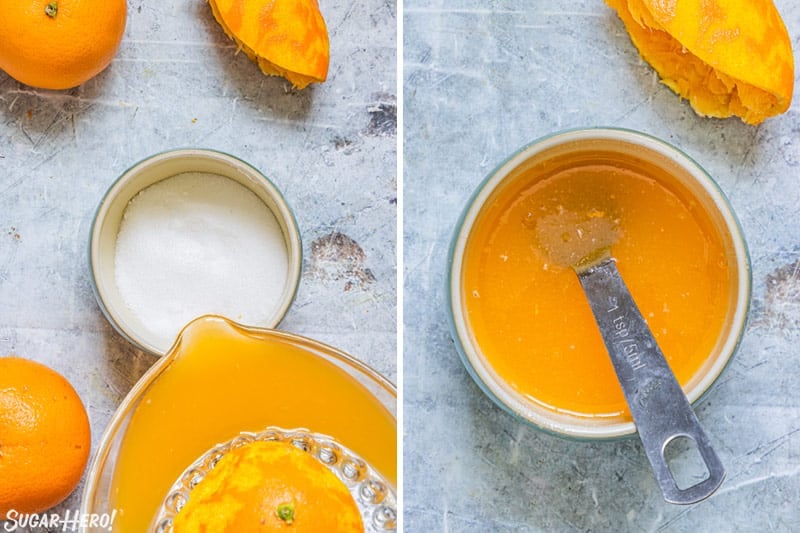
Making the Orange Soaking Syrup
One of the secrets to making this cake so tender is the orange soaking syrup. This is a delicious orange syrup that is poured over the hot cake, so that it soaks into every nook and cranny, giving it mega flavor and moistness.
- While the cake is baking, make the orange syrup by combining orange juice and granulated sugar in a small bowl. You’ll need to mix them together until the sugar dissolves.
- When the cake is done, remove it from the oven and set on a wire rack with the cake still in the bundt pan.
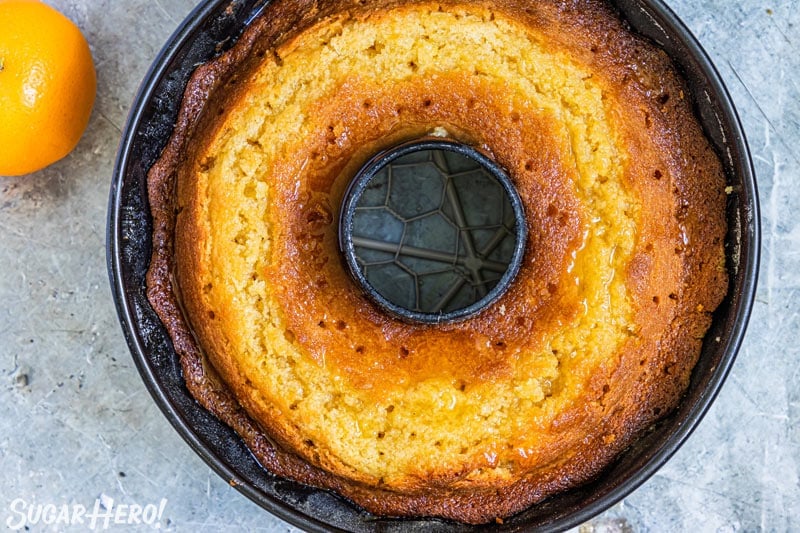
- Use a wooden skewer to punch holes all over the cake and then pour the orange syrup over the still hot cake and leave it to absorb. You’ll definitely want to do this when the cake is still hot from the oven so it absorbs well, so make sure to have the syrup ready to go.
- Let the cake cool in the pan, and once it is cool, invert it over a wire rack and remove the pan.
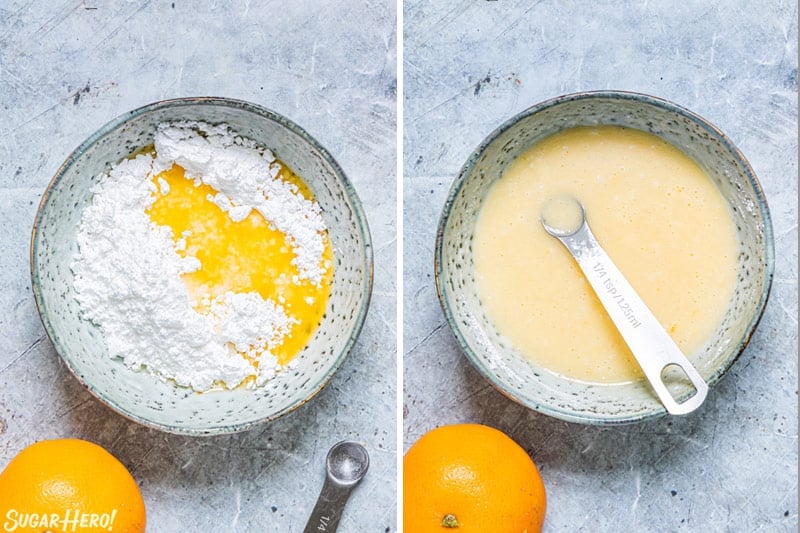
Making the Orange Glaze
The final step is drenching the cake with a tangy orange glaze!
- Whisk together the powdered sugar and orange juice. You should start with 1 to 2 tablespoons of juice, and gradually increase the amount of liquid until the glaze is the texture you like. It can be thin and syrupy, or thicker, like honey. Both ways will taste great!
- Pour the glaze all over the top of the cake. For added effect, you can top with bit more orange zest.
- Before serving, allow the glaze to set for 10 to 15 minutes. Once it is set, you can slice and serve the cake.
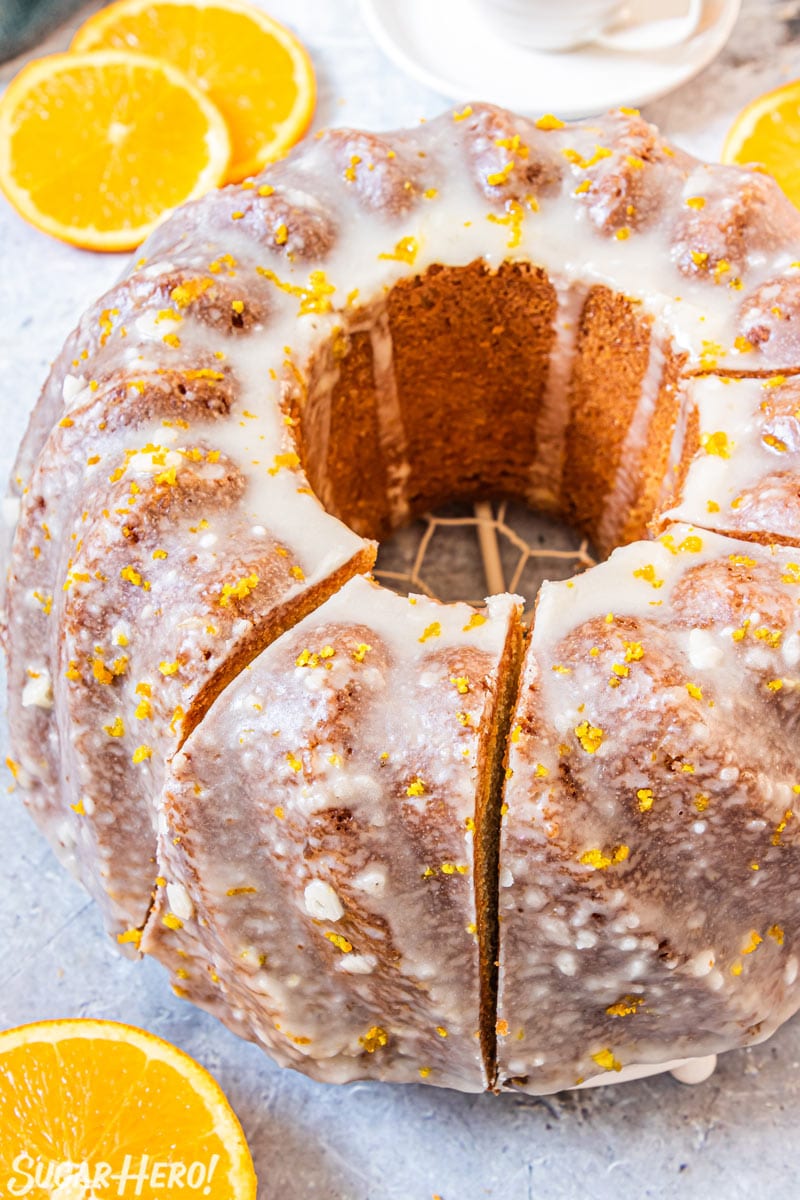
💭 Variations
Orange cake is just one option when it comes to this bundt recipe. If you want to experiment, here are some quick variations you can try:
- Use lime, lemon, grapefruit, clementine, tangelo, or another citrus fruit instead of orange. Or, mix and match these flavors for a unique citrus blend!
- Speaking of mixing and matching, you can add flavoring extracts to the citrus cake base. How about coconut and lime, or almond and lemon?
- If you follow a gluten free diet, you can substitute the all purpose flour for a gluten free variety.
- You can make a simple vanilla glaze for on top. Just mix in a teaspoon of extract and a bit of milk and skip the orange juice entirely.
For other great ideas, check out all of our bundt cake recipes! If decadent cake is your thing, check out all these great cake recipes too!
Have you read this far and decided a bundt isn’t for you. I’ll hook you up with a few of my favorite non-cake-based citrus treats: Key Lime Pie Recipe, Clementine Cookies and Peach Honey Ice Cream With Lemon Verbena.
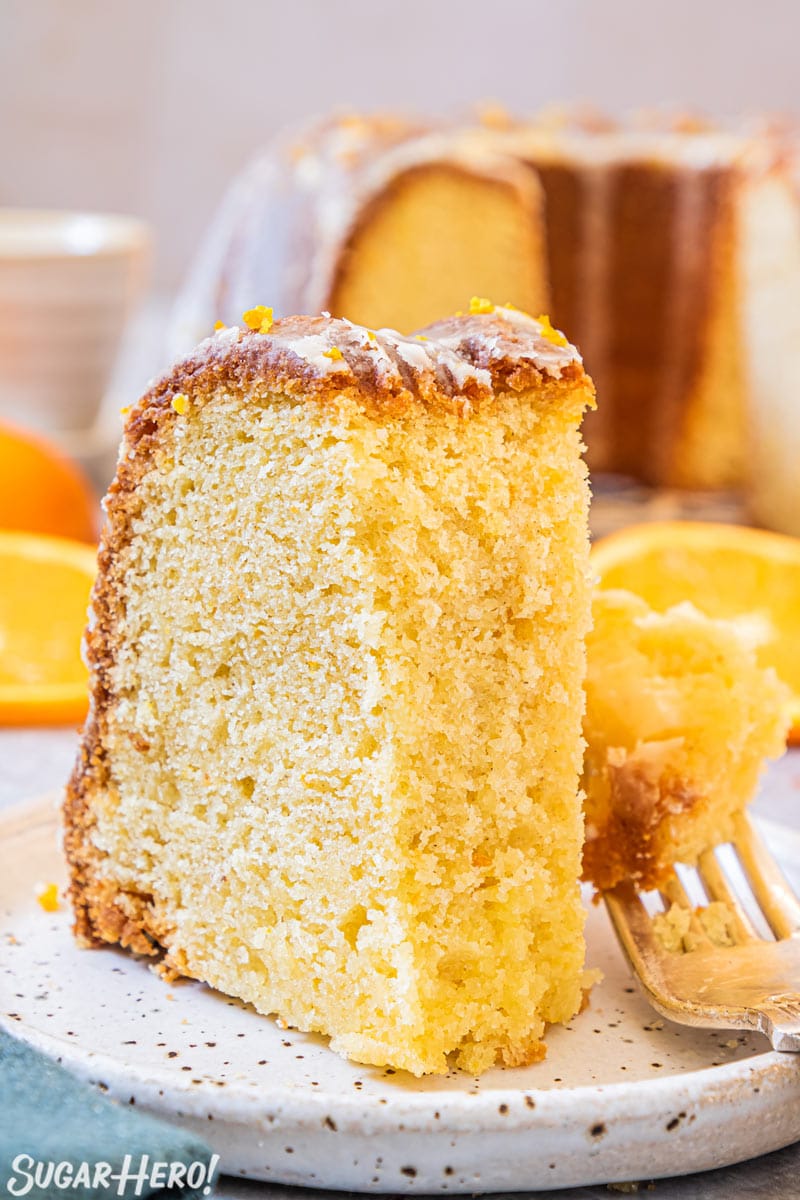
💡 Tips and FAQs
Whether you are a seasoned pro or a baking novice, these tips and questions may help you make sure the cake comes out great every time!
Do I need to grease a non-stick bundt pan?
YES YES A THOUSAND TIMES YES! Bundts are notorious for sticking in the ridges of their cake pans, so the more you can do to prevent them from sticking, the better. Yes, a non-stick pan surface and using cooking spray can help, but even with both of those precautions, you might run into trouble.
To make my life easier, I use and recommend this easy homemade recipe for pan release. This edible goop creates a nice layer between the cake and the pan, which means it should release easily once baked through. It takes less than 5 minutes to make, it’s made with 3 ingredients you probably already have, and you can keep a jar in your pantry so you’re always ready to bake! Seriously, give this cake goop a try and tell me it’s not life-changing!
If you don’t go the pan release route, then you should absolutely sprinkle a light layer of flour inside your bundt pan after you spray it with nonstick cooking spray.
What can I use instead of sour cream?
If you find yourself without sour cream or just prefer not to use it, a good substitute is full-fat, plain Greek yogurt. This creates a similar effect in the orange bundt cake, making it moist and rich. Another good choice is substituting room temperature buttermilk.
Make-Ahead and Storage Instructions
If you make the cake ahead of time for a party, don’t glaze it until shortly before you are ready to serve it (within a few hours is best). Without the glaze on top, you can wrap it tightly in plastic wrap, or store in an airtight container for up to 5 days in the refrigerator.
You can also freeze an unglazed cake for up to 2 months in the freezer. When you want to serve it, allow it to come up to room temperature and glaze it before serving.
If the cake is already glazed, store leftovers in an airtight container at room temperature for 3 days, or up to 5 days in the refrigerator. Note that the glaze might weep or liquify over time.
🍊 More Zesty Orange Desserts
Don’t miss the step-by-step tutorial showing how to make an Orange Bundt Cake – check out the web story here!
Leave a Review!
If you make this recipe, let us know! Leave a ⭐️⭐️⭐️⭐️⭐️ rating on the recipe below, and leave a comment, take a photo and tag me on Instagram @elabau, or use #sugarhero on IG!
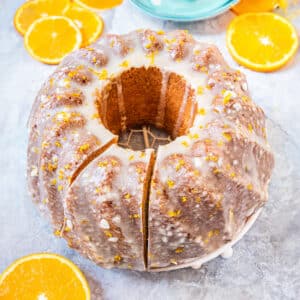
Orange Bundt Cake
Ingredients
For the Orange bundt cake:
- 9.50 oz all-purpose flour, (2 ¼ cups )
- 2 tsp baking powder
- ½ tsp salt
- 8 oz unsalted butter, (1 cup), softened
- 7 oz granulated sugar, (1 cup)
- Zest of 2 oranges
- 2 oz sour cream, (¼ cup), room temperature
- 2 tsp vanilla extract
- 3 large eggs, room temperature
For the Orange Soaking Syrup:
- Juice of 2 oranges, freshly squeezed
- 2.30 oz granulated sugar, (1/3 cup)
For the Orange Glaze:
- 4 oz powdered sugar, (1 cup)
- 2-3 TBSP orange juice, or orange juice concentrate
Instructions
To make the orange cake:
- Preheat the oven to 350°F. Brush a thick layer of pan release on the bundt pan, or spray it generously with nonstick cooking spray. (I recommend the “Baker’s” variety of nonstick spray with flour included.)
- In a small bowl, whisk together the flour, baking powder and salt, and set aside.
- Fit a large stand mixer with a paddle attachment. In the mixing bowl, cream together the butter and sugar until light and fluffy, 2-3 minutes.
- Add the orange zest, sour cream and vanilla and beat to combine.
- With the mixer on low speed, add the eggs one at a time and beat just until combined. Do not over mix. At this point, the batter might look curdled or broken, but don’t worry–it will come together when you add the flour mixture.
- Using a spatula, fold in the flour mixture just until combined.
- Transfer the batter to the prepared bundt pan and tap it gently a couple of times on the kitchen counter to level it.
- Bake the cake in the pre-heated oven for 50-60 minutes, or until a wooden skewer inserted into the center of the cake comes out with just a few moist crumbs attached. If the top seems to be getting too dark during the baking process, cover it loosely with a piece of foil and continue baking.
To make the orange syrup:
- While the cake is baking, make the orange syrup by combining the orange juice and granulated sugar in a small bowl, and mixing until sugar dissolves.
- When the cake is done, remove it from the oven and set on a wire rack with the cake still in the bundt pan
- Using a wooden skewer, punch holes all over the cake. Pour the orange syrup over the still hot cake and leave it to absorb.
- Let the cake cool in the pan, then when it is no longer warm, invert it over a wire rack and remove the pan.
To make the orange glaze:
- Make the orange glaze by whisking together the powdered sugar and orange juice. Start with 1-2 TBPS of juice, and gradually increase the amount of liquid until the glaze is the texture you’d like. It can be thin and syrupy, or thicker, like honey.
- Pour the glaze all over the top of the cake, and top it with a bit more orange zest, if desired.
- Let the glaze set for 10-15 minutes, then slice and serve.
- Leftovers can be stored, well-wrapped, at room temperature for up to 5 days.
Measuring Tips
Our recipes are developed using weight measurements, and we highly recommend using a kitchen scale for baking whenever possible. However, if you prefer to use cups, volume measurements are provided as well. PLEASE NOTE: the adage “8 oz = 1 cup” is NOT true when speaking about weight, so don’t be concerned if the measurements don’t fit this formula.
Want to learn more about baking measurements and conversion?
Nutrition
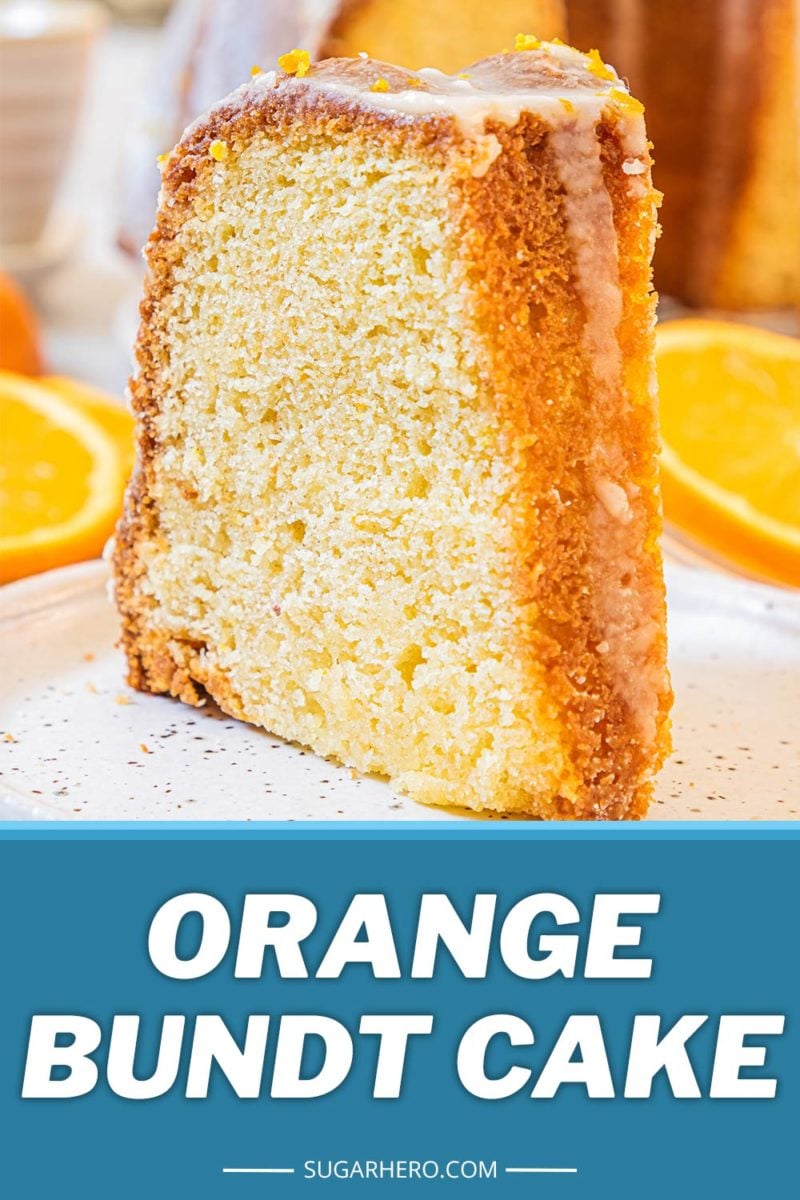
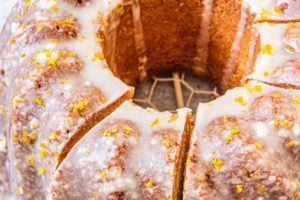
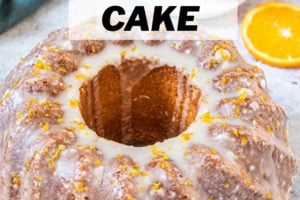
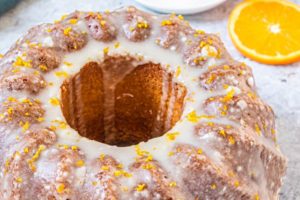
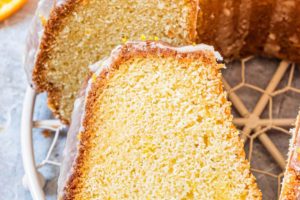
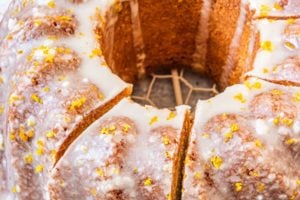
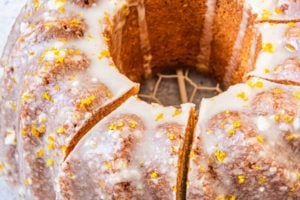
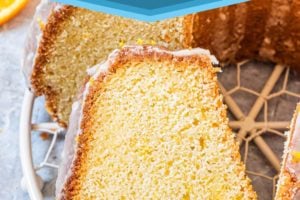


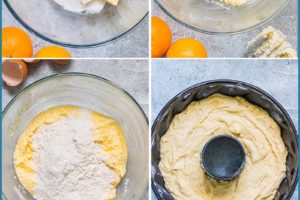

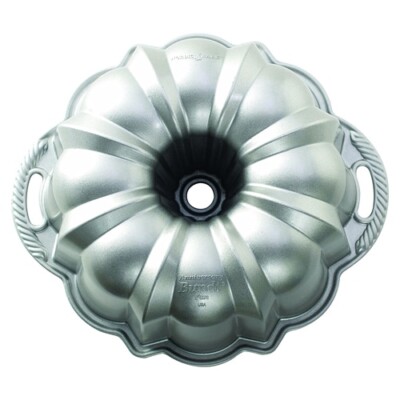
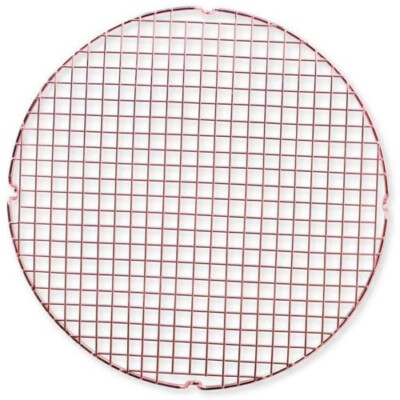
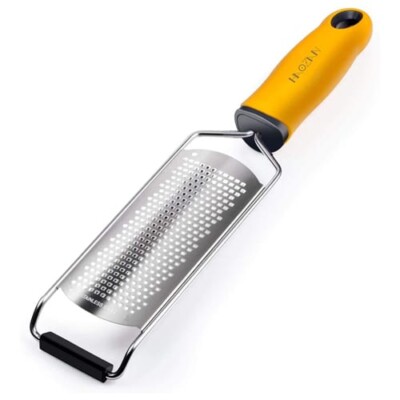
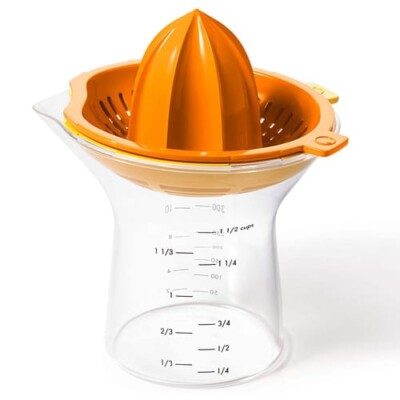
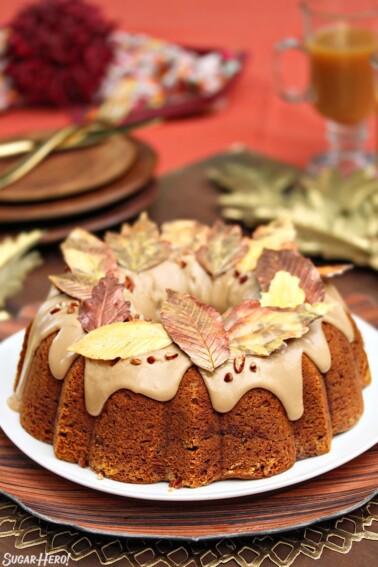
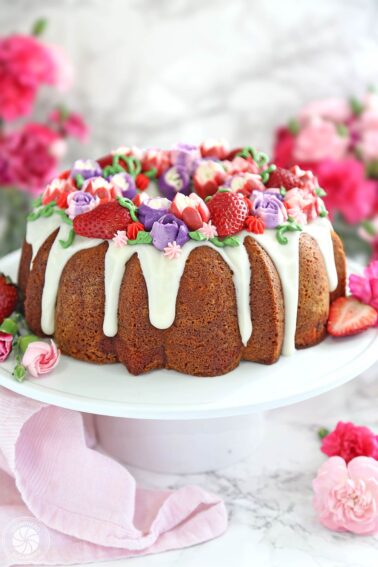
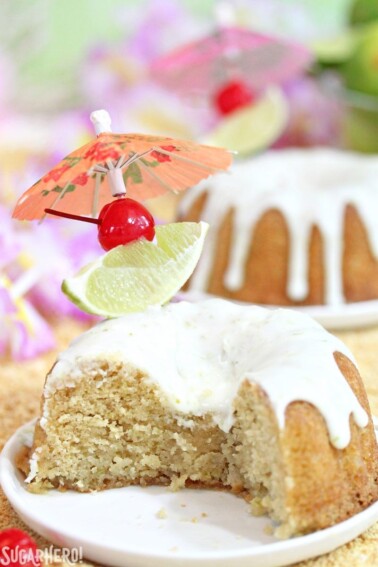
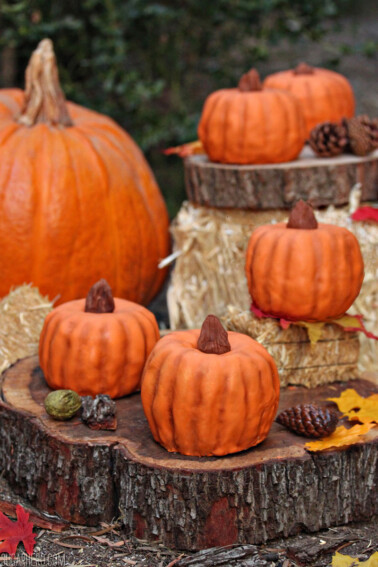












Still one of my Favorites….
An absolutely delicious cake. BUT mine did not turn out to be large at all. I suspected this might be the case when I noticed how small the amount of batter was in the bundt pan. So my slices were about half the size of the one in the picture. Nonetheless, the texture and the flavor were marvelous, and everyone loved it. Still, this took so much time and trouble to make that I doubt I will try it again.
Hi Linda,
So glad that you liked the flavor and texture of the cake! I bet the shape of your specific bundt pan might have something to do with how the slices turned out. We really appreciate the time you took to leave a comment and rating. All the best to you.